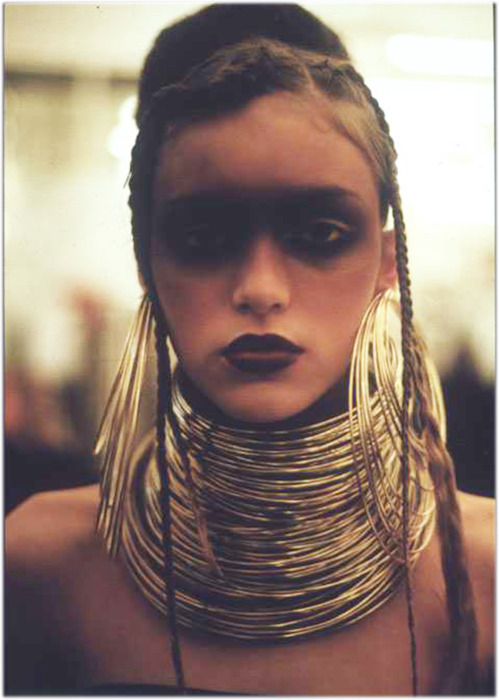McQueen often remarked that he found beauty in areas that society generally perceives as 'ugly' or 'savage' - in general, high-fashion has a fascination with beauty but sometimes designers delve deeper and explore different concepts and draw inspiration from obscure places, and it is at this point that a collection truly becomes unique. As usual, McQueen presented a highly-researched collection that took the aesthetic of the ancient Yoruba tribe and brought it up to date with a decidedly chic twist - the collection can be seen in full here.
When I first started researching McQueen's collections I usually looked at the clothes themselves and was blown away by the amount of detail and craftsmanship in every look - it was when I first started watching the runway shows themselves that I fell in love with the man and his many talents. The true genius of McQueen's aesthetic is that he looks to contort society's ideal of beauty by taking the macabre and making it wearable. Take this collection, for example - models were sent down the runway with heavy steel piercing and a select few saw their bare gums exposed by steel rods that contorted the face in a grotesque manner. Combined with yellow powder that was liberally dusted along hairlines to give the impression of partial baldness, this collection was certainly not beauty in a traditional sense.
However, despite the extreme hair and make-up it was the collection that captured the attention of the front row. From ethereal cotton dresses in a variation of dyed fabrics right through to chic leather separates, an impressive amount of the collection was surprisingly wearable. Certain monochrome looks featured just a touch of fur to add interest, while McQueen's inimitable take on silhouette were enough to take a simple trouser-suit into the realm of effortless high-fashion.
However, it was when McQueen showcased the more dramatic looks of the collection that people really began to take notice. Evening gowns were made by laser-cut leather being draped over a tough metal frame (part of which was still visible beneath the fabric), providing a tribal take on a traditional crinoline. Elsewhere, full-length coats were made from woven hair - hair was a theme throughout the collection, whether it was a mohair skirt on a cocktail dress or twisted hair used to create oversized épaulettes. The collection was McQueen's first showing in Paris as opposed to London, so in that sense this collection (inspired by the Yoruba tribespeople of West Africa) was the designer's début showing in the major leagues of fashion. Still one of his most memorable collections, it is a true testament to the legacy that the legend has left behind.




No comments:
Post a Comment